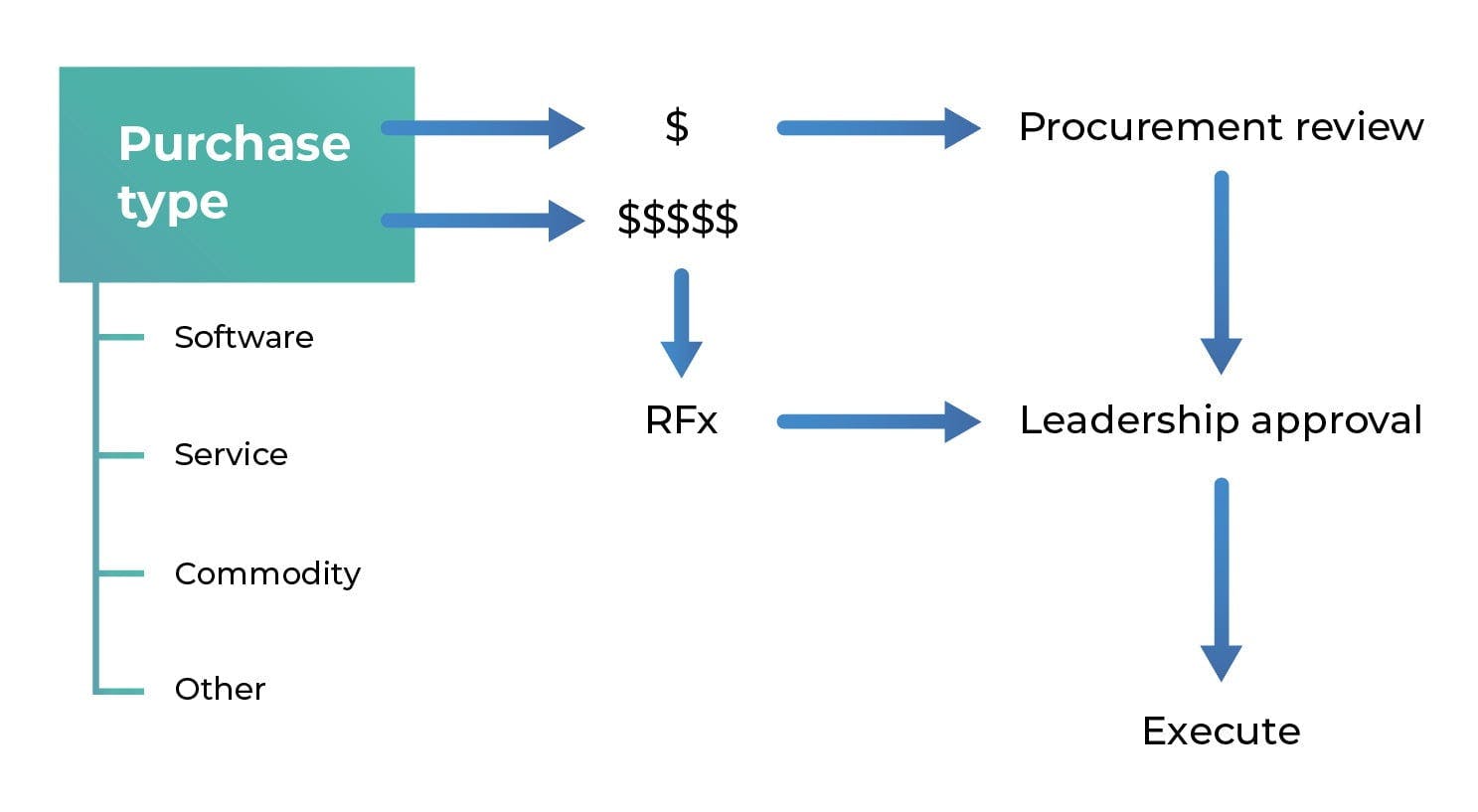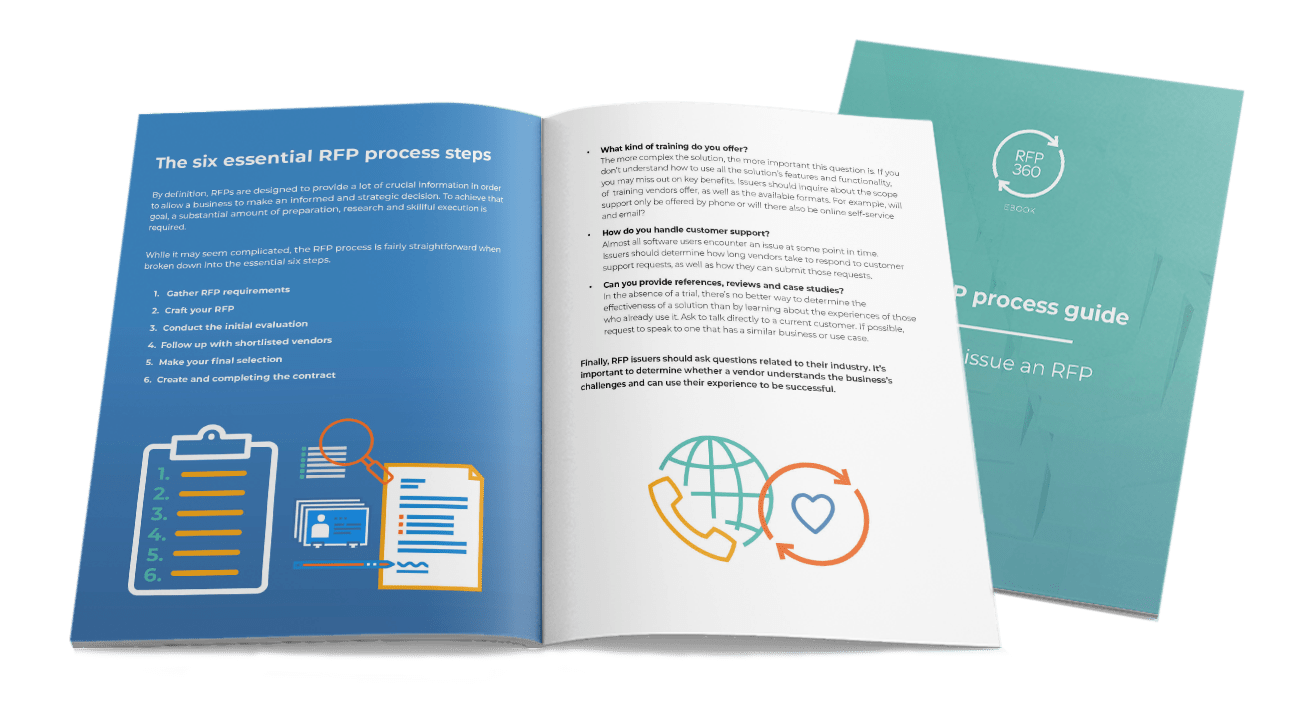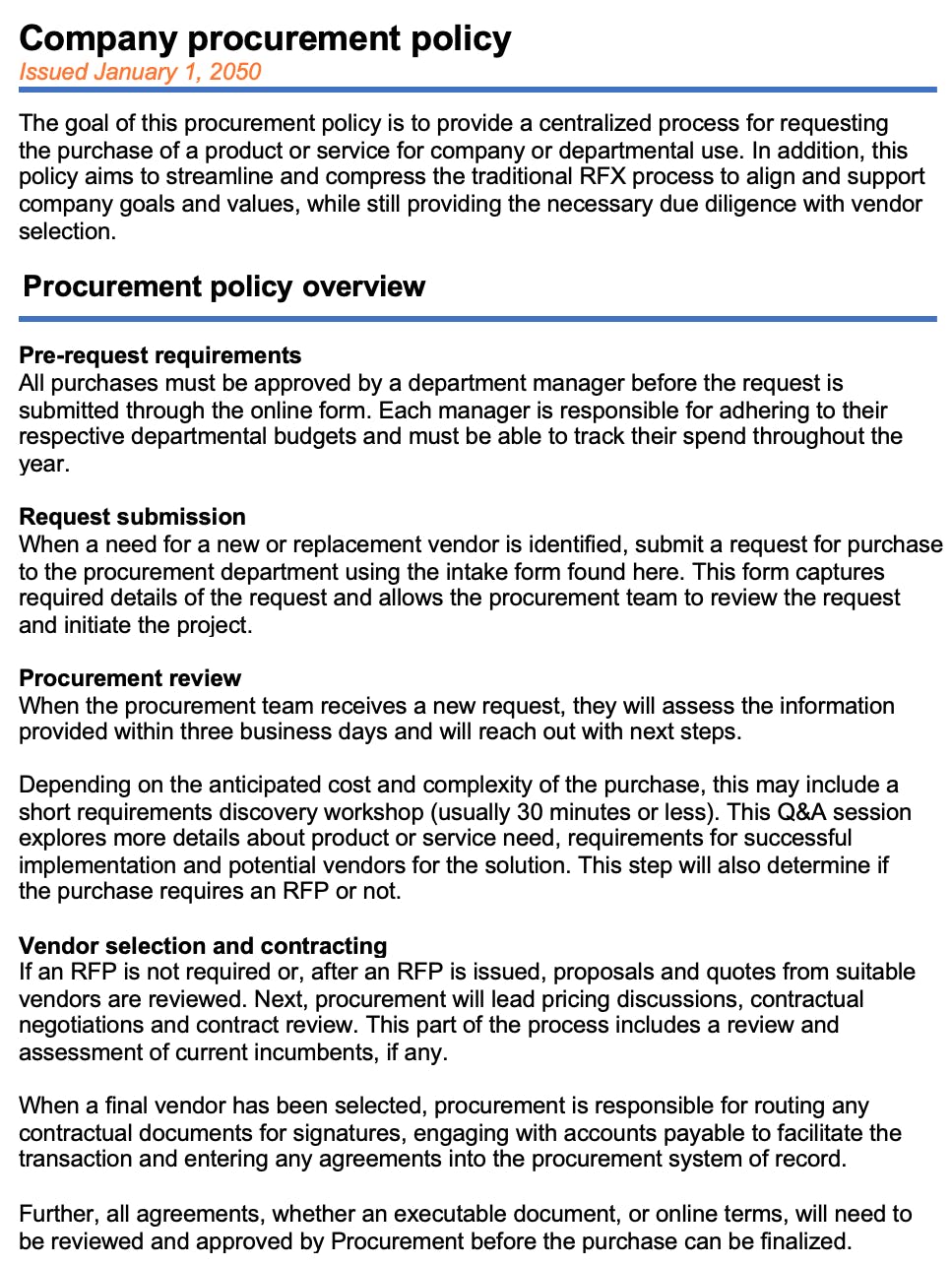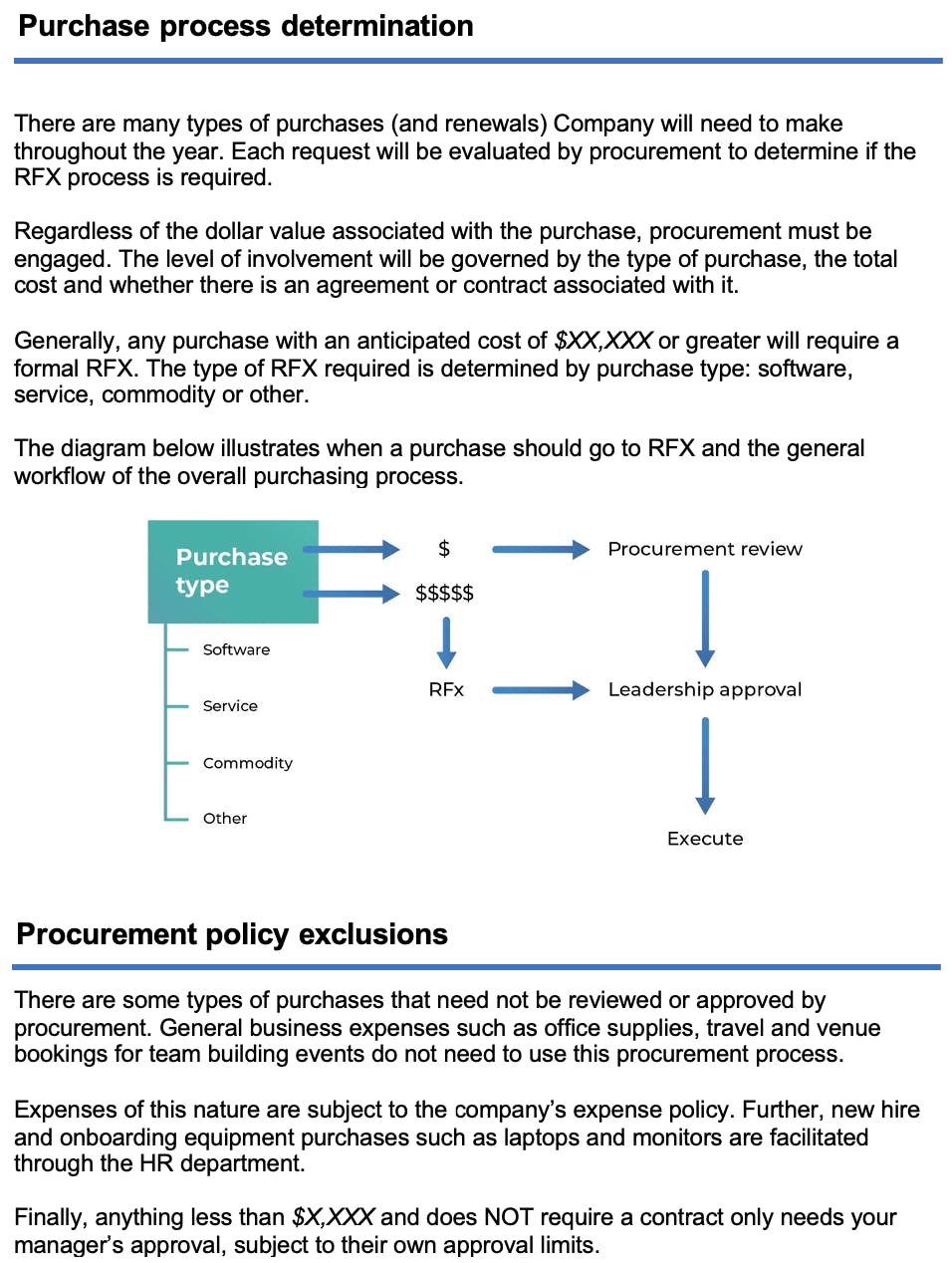Writing a procurement policy is a big undertaking. If you’re considering creating a new policy, you may find yourself asking: Why do we need one? What should it say? Will people actually follow it? What will it accomplish? All good questions — and ones I asked myself as I set out to create a procurement policy for RFPIO and RFP360.
My ultimate goal was to empower our team with an efficient process while also protecting the organization from risk. As I researched and considered, I was disappointed to find lots of outdated practices, inefficient policies and over engineered processes. So, I wanted to share what I’ve learned to help others in a similar position.
In this blog, we’ll explore everything you need to know about procurement policies. We’ll start with the basics: What is a procurement policy? How do you know if you need one? And, what should be in it? Next, we’ll go through the steps of how to write your first procurement policy (or update an old one). Finally, we’ll offer a procurement policy example and template.
- Procurement policy basics
- How to write a procurement policy
- Quick tips for success
- Sample procurement policy and template
Procurement policy basics
What is a procurement policy?
A procurement policy is a set of guidelines used to establish and standardize the procedure for purchasing goods and services within an organization. Also called a purchasing policy, it provides specific instructions to help employees successfully navigate common procurement scenarios.
Why do businesses create procurement policies?
Often, small businesses don’t have a procurement policy, because they only have a few employees and don’t often buy expensive goods or services. This is particularly true in businesses that provide services rather than a physical product. For these organizations, tracking budget and spend is relatively simple. Therefore, a formalized procurement policy isn’t necessary because the few employees that have purchasing power also have direct visibility to the company’s needs. However, the story usually changes as the business grows.
As an organization grows, so too does the need to spend. For instance, the sales department needs software. A consultant is hired to help with product development. And, the marketing team wants to buy ads. Before you know it, money is flying out the door from every department and you have no idea where it’s going or why. It makes it difficult to know where the bottom line is. This is a common scenario for rapid-growth businesses.
Fortunately, a procurement policy helps get things back on track. Indeed, the goal of a formalized policy is to improve spend visibility, increase consistency, control maverick spend and reduce risk.
What should a procurement policy cover?
Every business has unique needs. Consequently, there’s no one-size-fits-all procurement policy. However, if you explore sample procurement policies, common themes emerge. While the contents of each policy should be customized to address the business’s needs, there are a few sections that most procurement policies include.
Sections in a procurement policy
Policy objective
Introduce your procurement policy by sharing why it was created. What are the goals of the policy? For example, our own policy begins with this short statement:
Objective: Provide a centralized process for requesting the purchase of a product or service for company or departmental use. Streamline and compress the traditional RFX process to be in-line with company goals and values, while still providing the necessary due diligence with vendor selection.
Process overview
Give a high-level summary of the procurement process. Share a brief description of the steps in the process. In addition, it’s helpful to include a workflow diagram if possible to illustrate the process.
- Submit a procurement request form with general information about the need
- Procurement reviews the request and gathers more specific information
- Based on the needs and impact, the request may require an RFX
- A vendor is selected and the purchase moves through executive approvals
- Contract negotiation and execution

Procurement thresholds
Give guidelines for what level of spend requires procurement oversight. For instance, it’s not a good use of procurement’s time to approve the purchase of every stapler. However, for larger purchases, it’s important to protect the business from risk.
Outline a few common scenarios: When does a purchase need to be approved and through what channels? At what level of spend or impact is an RFX required? The answers to these questions will be different for every organization.
RFX process
This section offers an overview of your RFX process for purchases that meet the established criteria. Whether you use a request for information, request for proposal or request for quotation (RFI, RFP or RFQ), the steps of the process are similar.
Not sure which RFX to use? Check out this infographic, RFX selection guide: RFI vs RFP vs RFQ.
- Gather RFX requirements
- Establish scope and evaluation criteria
- Create the RFX questions
- Select vendors and issue the request
- Review, score the RFX and select a winner
If you use Word and Excel to manage your RFP process, you’ll need to keep track of all of the documents separately. However, if you use RFP management software the entire RFX workflow happens in a single, centralized place.
To explore the RFP process in more detail, check out this ebook: The RFP process guide.

Sustainability and diversity statement
Organizations that have sustainability and diversity goals often include a brief overview of their initiatives in their procurement policy. Typically, this section simply serves as a quick reminder. Rather than going into detail, consider linking to sustainable sourcing and supplier diversity policies.
Ethics and anti-bribery
Like the sustainability and diversity statement, the ethics and anti-bribery section often links to a more detailed policy. However, it serves as a reminder of best practices when making purchasing decisions and awarding contracts. This section is common in larger organizations, regulated businesses or nonprofits that regularly make substantial purchases.
Other sections found in procurement policies
In addition to the common procurement policy sections found above, depending on the needs of your business, you may also consider including:
- Supplier selection policy
- Contracting requirements and review process
- Signature authority guidance
- Key procurement definitions
- Common questions and answers
How to write a procurement policy
1. Define your goals and needs
Before you put pen to paper to start writing your procurement policy, spend some time thinking about what it needs to accomplish.
For example, businesses that are scaling rapidly need a purchasing policy that enables them to maintain momentum while still protecting the business. On the other hand, established organizations may struggle with maverick spend. Their procurement policy needs to be clearly defined and easy to navigate to encourage compliance.
So, what are your goals and needs?
- Improve spend visibility
- Provide parameters for small, low-impact purchasing
- Increase process consistency
- Control maverick spend
- Improve procurement speed
- Reduce third-party risk
- Gather data for procurement analytics
As you write the policy, keep this information in mind. Which of these goals is your top priority? Does every step of your procurement process help achieve one or more of these goals?
2. Research and write
While no two procurement policies should be identical, it certainly helps not to start by staring at a blank page. So, it’s wise to do some research, review a few examples and check out a template (see below).
Then, start writing section by section. Remember, try to keep it as concise and clear as possible. Make good use of section headers, short paragraphs and sentences, minimal jargon and bullet points.
Things to consider when drafting a procurement policy
- Does this policy improve or support our ability to audit spend?
- Is it easy to understand and navigate?
- Does it maximize the value procurement adds to purchasing?
- Is it effective and efficient for both users and procurement?
- Can it be easily scaled to accommodate growth?
- Does it protect our business from risk?
- Can we easily gather vendor and contract data?
3. Stakeholder review and approval
Once you have your first draft, it’s time to solicit feedback from a few key stakeholders. One by one, engage the necessary parties. Generally, it’s best to start with your manager or direct supervisor. Then, move on to operations, legal, finance, IT or any other departments that are regularly involved with purchasing that might offer helpful input.
Admittedly, writing and editing by committee is always a risk, so approach stakeholders with the intent to inform and consult. It’s important to welcome suggestions, but carefully consider edits. Above all, remember your goals. Does the suggestion add time but not significant value? Always weigh the benefit versus the impact on your end-user.
When you’ve arrived at your final draft, submit it for executive approval. With any luck, you’ll emerge with an official procurement policy that empowers users and protects your business.
Quick tips for success
Ensure it’s scalable
Writing a procurement process and policy takes a lot of time. So, write it to last a while. How will the policy fare if your company doubles in size over the next year? If twice as many people are coming to you with requests, is the workload manageable with the current policy? Compliance and consistency go hand-in-hand when it comes to procurement policies.
Write your own rules
Don’t let yourself feel constrained by what other businesses do. If a low spend threshold before requiring an RFP causes tons of work for procurement and yields minimal savings, change it. Many common procurement practices cause the challenges that make the process painful. Creating a policy without considering how it would actually work in your organization won’t do you any favors in the long run. Take this opportunity to think differently.
Make it modular
Procurement projects come in all shapes and sizes — and your procurement policy should accommodate that. Making your process modular means only using the right parts of the process for the right projects. The flexibility will improve efficiency.
Some projects will need the full-court press before moving forward: internal approvals, requirements discovery, an RFI, vendor selection process, a full RFP, a vendor risk assessment, a vendor evaluation process, negotiations and final contracting. While another low-value contract may just need a 10-question RFP lite and a risk assessment. Your procurement policy shouldn’t make the process harder than it needs to be.
Use an intake form
Creating an easy intake form makes it simple for stakeholders to engage with procurement. In addition, it makes it easy for you to determine what level of procurement involvement is required. Basic fields to include:
- Name of requestor
- Type of request (good or service)
- Description of purchase
- Budget or expected spend
- Department owner
You can’t plan for everything — so don’t
Don’t get caught up in writing policies and scenarios for every possible outcome. If you do, you’ll end up with 25 pages of unreadable, difficult-to-navigate red tape. Besides, I can tell you from experience, your team will always come up with a crazy curveball you haven’t planned for. Instead, focus on communicating the goals and intent of the policy. That way, stakeholders know what kinds of situations require collaboration with procurement.
Ask for feedback and optimize
While consistency is crucial for compliance, don’t live with a bad or broken process just because it’s what you’ve always done. As you receive requests and complete projects, ask stakeholders for candid feedback on the process. Gather that feedback and once a year, set aside time to review what’s working and what isn’t. Additionally, consider if there are any new procurement trends that would serve your business well. There’s always room for improvement.
Sample procurement policy and template
Still not sure where to start? No problem. Check out this procurement policy sample to inspire your own.
Or, download it to customize it to your needs: Free procurement policy template download.


Ultimately, you want stakeholders to view the procurement team as a resource, not a roadblock. Admittedly, it’s a bit of a balancing act. You must meet needs, solve problems and move quickly while managing spend and risk. It’s not easy, but your procurement policy can help by offering guidance that empowers users and protects your business.

